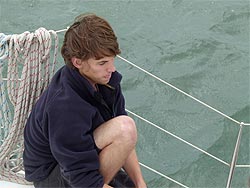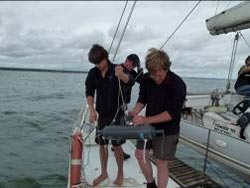Marine Scientist Profile:
1. Name: Simon Sharp
2. Organisation / Company: EPA Victoria
3. Title of your Two bays Project: Western Port Continuous Monitoring
4. How long have you been working with Two Bays? One year
5. Qualifications/ job title: Marine and Freshwater Monitoring Scientist.
6. As a marine Scientist, why is the Two Bays project so important? To better understand temporal changes in the water quality within Western Port.
7. What is the “wow factor” that you would use to enthuse a young person about your chosen profession? The best part is getting out on the water and seeing marine life including seals, dolphins, fish and birds all mixing together in the currents and waves and collecting information to examine the conditions affecting their home.
8. Same as question above, but replace your ‘profession’ with ‘Victoria’s Marine Environment’ – Seeing life beneath the waves, whether it is while diving, snorkling or surfing and appreciating the diversity of creatures that we share this habitat with.
9. What led you to a career in marine Science? I developed a strong fascination withnature through constant exposure to the beach, rivers and bush, and our natural environment is the strongest way that I relate to learning.
10. Is there an interesting story that you can share that convinced you to study marine science? – During university, we stayed on a tropical island in the Great Barrier Reef and studied the movement of fish, and life on the coral reef, where we were greeted by an enormous sea turtle swimming above us as we went about our class in the ocean.
11. What is the greatest threat to Victoria’s marine environment? The increase and introduction of new and established exotic species, which can over-run and out-comete our native marine habitats. Examples include sea stars, seaweeds and crabs.
|
|
12. What is the most important thing we should do to protect our marine environments? Clean and clean up our rubbish, including fishing gear, which eventually makes its way to our oceans. Plastic is a particularly persistent problem, as it breaks down into smaller peices and is eaten by many fish. Plastic bags and nets can also suffocate larger marine animals such as seals and turtles.
13. When you grow up, what do you want to be? A sea turtle biologist and a wildlife photorapher, of sea turtles! 

|

